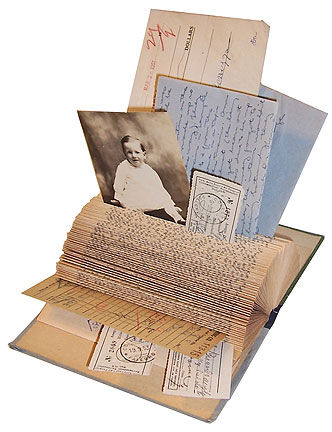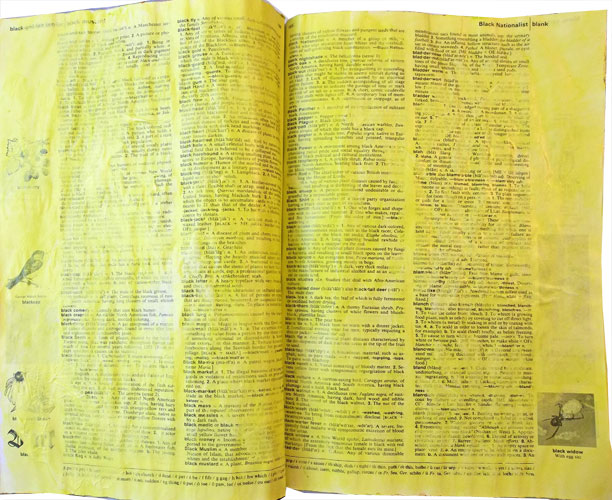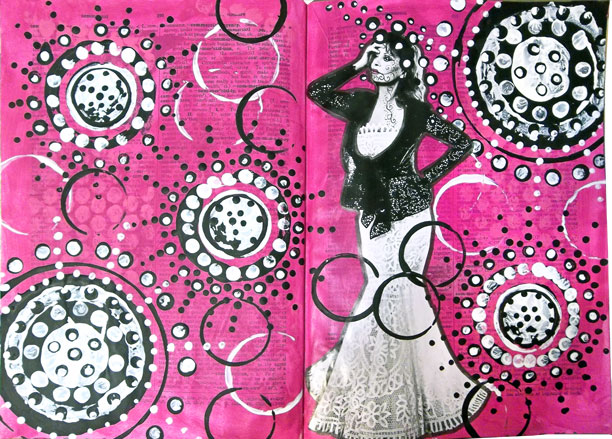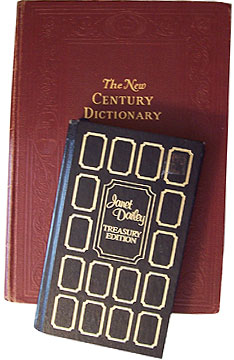 In altered book circles, there’s a lot of talk about sewn spines vs. glued spines. Sewn spines are preferred because they usually give the book more strength and durability. There’s less risk of breaking the spine of a sewn book, and it’s much easier to remove pages without damaging the structure. When given a choice, most altered book artists will go for a sewn spine rather than a glued one.
In altered book circles, there’s a lot of talk about sewn spines vs. glued spines. Sewn spines are preferred because they usually give the book more strength and durability. There’s less risk of breaking the spine of a sewn book, and it’s much easier to remove pages without damaging the structure. When given a choice, most altered book artists will go for a sewn spine rather than a glued one.
OK, so how do you tell if a book is sewn rather than glued? It’s pretty simple, once you know what you’re looking for.
First, let’s look at my two book examples. I always flip the book open and look and the publishing date, which you can find somewhere on the first half dozen pages, with all the copyright disclaimers. My first book is a copy of The New Century Dictionary from 1956, and the second is a hardbound Harlequin Romance from 1985. A good thing to know here: reference books are generally designed to have a long life, and take lots of abuse. Novels are designed to be read a couple of times, and then put on a shelf. This is particularly true the later you move into the 20th century. Newer novels are almost always glued, while older reference books are almost always sewn. Now you know why old dictionaries are so popular with altered book artist.
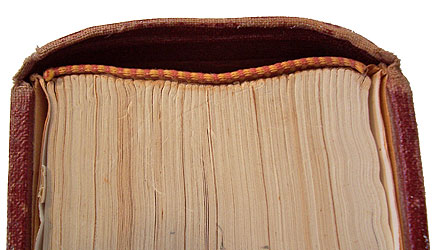 Here’s an overhead closeup of the spine of my dictionary. See that piece of fabric-looking stuff? That’s the headband, and it’s a piece of heavyweight twill. Even though the book is old and worn, the headband is still in pretty good shape. See how flexible it is—how it curves easily, and pulls far away from the headcap (the outside spine of the book)? That’s one sign that it hasn’t been stiffened by a lot of glue.
Here’s an overhead closeup of the spine of my dictionary. See that piece of fabric-looking stuff? That’s the headband, and it’s a piece of heavyweight twill. Even though the book is old and worn, the headband is still in pretty good shape. See how flexible it is—how it curves easily, and pulls far away from the headcap (the outside spine of the book)? That’s one sign that it hasn’t been stiffened by a lot of glue.
Notice all the scallops of pages pushed up against the headband? Those are signatures. Each scallop is a single signature. They’re made when the pages are folded together to prepare for stitching. If you can clearly see the signatures rippled against the headband, that’s a good sign.
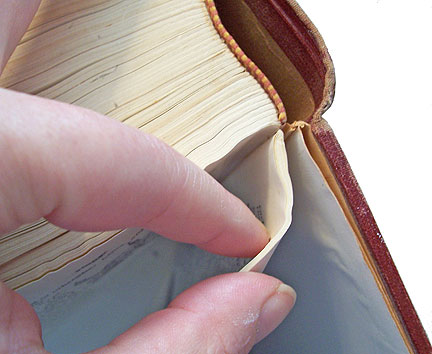 Here, I’m holding a single signature. It was really easy to do this—also a good sign. With glued spines, it’s often very difficult to tell where one signature begins and the next ends—assuming they even have signatures.
Here, I’m holding a single signature. It was really easy to do this—also a good sign. With glued spines, it’s often very difficult to tell where one signature begins and the next ends—assuming they even have signatures.
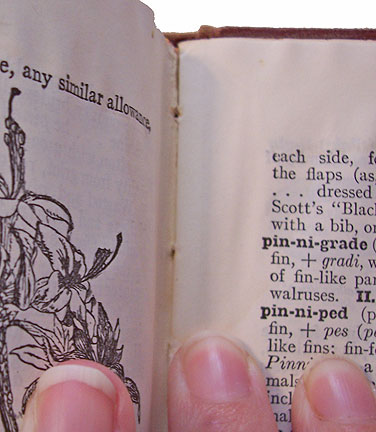 If I open the book and lay it flat on a table, still holding the first signature, this is what I see. Those dots are stitching marks, and since this book is a little loose, you can also see a bit of thread. The signature is not attached to the spine by any other means—there’s no stiffness here, or gluing. I think we have a sewn spine, but let’s check one more thing.
If I open the book and lay it flat on a table, still holding the first signature, this is what I see. Those dots are stitching marks, and since this book is a little loose, you can also see a bit of thread. The signature is not attached to the spine by any other means—there’s no stiffness here, or gluing. I think we have a sewn spine, but let’s check one more thing.
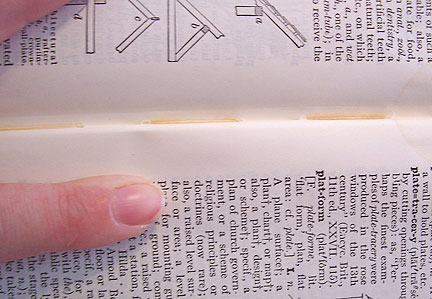 If I open the signature to its center, by counting an equal number of pages from the front and back page of it, I should find stitching lines. Here they are, running right up the spine of the book. This is definitely a sewn spine.
If I open the signature to its center, by counting an equal number of pages from the front and back page of it, I should find stitching lines. Here they are, running right up the spine of the book. This is definitely a sewn spine.
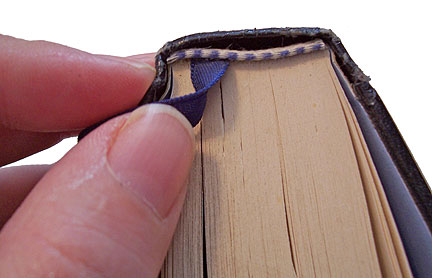 Now, let’s look at my little novel. Here, it’s really hard to see the scallops of the signatures against the headband. The headband is very stiff and straight, and the pages appear to be pushed straight up against it. If I look closely, I can also see a small line of glue between the pages and the headband. I think this is a glued spine.
Now, let’s look at my little novel. Here, it’s really hard to see the scallops of the signatures against the headband. The headband is very stiff and straight, and the pages appear to be pushed straight up against it. If I look closely, I can also see a small line of glue between the pages and the headband. I think this is a glued spine.
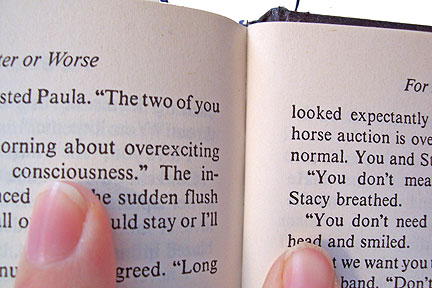 When I open the book and pull the pages taught to inspect the spine, I don’t see any stitching. The pages seem to pull away only so far, and then get stuck. I can see that this book is glued. If I were to bend the spine of this book backward (which I won’t do unless I’ve already purchased it), I would hear the glue cracking—and chances are, I could break the book if I bent it far enough. This not a good book for altering, particularly if you’re an artist that likes to use a lot of dimensional embellishment. The chances are good that this book will not survive heavy altering—and there’s nothing more heartbreaking than breaking the spine of a book after you’ve worked on it for endless hours.
When I open the book and pull the pages taught to inspect the spine, I don’t see any stitching. The pages seem to pull away only so far, and then get stuck. I can see that this book is glued. If I were to bend the spine of this book backward (which I won’t do unless I’ve already purchased it), I would hear the glue cracking—and chances are, I could break the book if I bent it far enough. This not a good book for altering, particularly if you’re an artist that likes to use a lot of dimensional embellishment. The chances are good that this book will not survive heavy altering—and there’s nothing more heartbreaking than breaking the spine of a book after you’ve worked on it for endless hours.
Glued books are good for some things. I usually have a few around that are earmarked for making niches. I would glue all the pages together, and reinforce the inner covers, so there’s no risk of breaking the spine. They’re also good for tearing up to use as text pages. While almost all the books I have in my pile to be altered are sewn, almost all foreign text books in the bottom of my paper file are glued spines. The pages peel right out when I need them, just like tearing them from a notepad. Keep this in mind if you find a book with a glued spine—even if it can’t be altered, it can be used as background paper.

